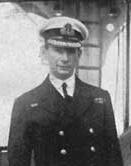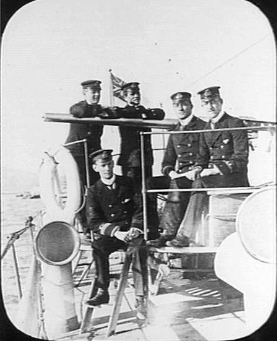|
Percy Douglas
Vice-Admiral Sir Henry Percy Douglas (1 November 1876 – 4 November 1939) was a British naval officer who specialised in surveying and was Hydrographer of the Navy. Career Henry Percy Douglas was educated at Eastman's Royal Naval Academy, Southsea before entering the Royal Navy training ship as a cadet in 1890. In 1892 he was appointed to as a midshipman. In 1894 he was part of a landing party at Bluefields during the Nicaraguan campaign to annex the Mosquito Coast. In 1895 he was transferred to the newly launched as acting sub-lieutenant; his promotion was confirmed in March 1896 and he was appointed to , the first of the many surveying ships in which he served at various times all over the world. In 1898 he was promoted to lieutenant. In 1908, still with the rank of lieutenant, he was given his first command, the surveying ship . From 1910 to 1914 he was Superintendent of Charts in the Hydrographic Department of the British Admiralty. He was promoted to Commander ... [...More Info...] [...Related Items...] OR: [Wikipedia] [Google] [Baidu] |
Bebington
Bebington () is a town and unparished area within the Metropolitan Borough of Wirral, in Merseyside, England. Historically part of Cheshire, it lies south of Liverpool, close to the River Mersey on the eastern side of the Wirral Peninsula. Nearby towns include Birkenhead and Wallasey to the north-northwest, and Heswall to the west-southwest. Bebington railway station opened in 1838 and is situated on the Wirral line of the Merseyrail network. The electoral ward, which includes the original village centres of Higher Bebington and Lower Bebington, had a total resident population of 13,720 at the 2001 census. which increased to 15,768 at the 2011 census. Some definitions of Bebington include adjoining areas such as Port Sunlight (an early planned factory town), New Ferry, Spital and Storeton. The former Municipal Borough of Bebington, a local authority between 1937 and 1974, also included within its boundaries Bromborough, Eastham, Raby, Thornton Hough and Brimstage, which ... [...More Info...] [...Related Items...] OR: [Wikipedia] [Google] [Baidu] |
Sub-lieutenant
Sub-lieutenant is usually a junior officer rank, used in armies, navies and air forces. In most armies, sub-lieutenant is the lowest officer rank. However, in Brazil, it is the highest non-commissioned rank, and in Spain, it is the second highest non-commissioned rank. As a naval rank, a sub-lieutenant usually ranks below a lieutenant. Armies and air force rank In France, a sub-lieutenant () is the junior commissioned officer in the army or the air force. He wears a band in the colour of his corps (e.g. gold for infantry, silver for armoured cavalry, etc.). During the 18th century a rank of existed in the French Navy. It was the equivalent of the master's mate rank of the Royal Navy. It is now replaced by the rank of "first ensign" (). An Argentinian sub-lieutenant wears a single silver sun on each shoulder, Brazilian sub-lieutenants are the most senior non-commissioned rank (called Sub-Officer in the Navy and Air force), wearing a golden lozenge. In Mexico, the sub-lieute ... [...More Info...] [...Related Items...] OR: [Wikipedia] [Google] [Baidu] |
Antarctica
Antarctica () is Earth's southernmost and least-populated continent. Situated almost entirely south of the Antarctic Circle and surrounded by the Southern Ocean, it contains the geographic South Pole. Antarctica is the fifth-largest continent, being about 40% larger than Europe, and has an area of . Most of Antarctica is covered by the Antarctic ice sheet, with an average thickness of . Antarctica is, on average, the coldest, driest, and windiest of the continents, and it has the highest average elevation. It is mainly a polar desert, with annual precipitation of over along the coast and far less inland. About 70% of the world's freshwater reserves are frozen in Antarctica, which, if melted, would raise global sea levels by almost . Antarctica holds the record for the lowest measured temperature on Earth, . The coastal regions can reach temperatures over in summer. Native species of animals include mites, nematodes, penguins, seals and tardigrades. Where vegetation o ... [...More Info...] [...Related Items...] OR: [Wikipedia] [Google] [Baidu] |
Discovery Committee
The Discovery Committee was a popular name for the Interdepartmental Committee for the Dependencies of the Falkland Islands established by the British Government to carry out scientific investigations (which became known as ‘Discovery Investigations’) and to propose nature resource conservation and economic development policies for the Falkland Islands Dependencies. During more than 25 years (1925–51) of pioneering work, the Committee's research ships ( Robert Scott’s ship), and collected an enormous amount of oceanographic, biological, and geographical data published in 38 volumes, contributing greatly to the knowledge of the world's southern regions. Particularly extensive was the new data related to all aspects of the island of South Georgia. Among the results of the investigations was also the discovery of the natural boundary of Antarctica, the Antarctic Convergence. See also * Discovery Investigations * History of South Georgia and the South Sandwich Islands ... [...More Info...] [...Related Items...] OR: [Wikipedia] [Google] [Baidu] |
First Ostend Raid
The First Ostend Raid (part of Operation ZO) was the first of two attacks by the Royal Navy on the German-held port of Ostend during the late spring of 1918 during the First World War. Ostend was attacked in conjunction with the neighbouring harbour of Zeebrugge on 23 April in order to block the vital strategic port of Bruges, situated inland and ideally sited to conduct raiding operations on the British coastline and shipping lanes. Bruges and its satellite ports were a vital part of the German plans in their war on Allied commerce ('' Handelskrieg'') because Bruges was close to the troopship lanes across the English Channel and allowed much quicker access to the Western Approaches for the U-boat fleet than their bases in Germany. The plan of attack was for the British raiding force to sink two obsolete cruisers in the canal mouth at Ostend and three at Zeebrugge, thus preventing raiding ships leaving Bruges. The Ostend canal was the smaller and narrower of the two channels g ... [...More Info...] [...Related Items...] OR: [Wikipedia] [Google] [Baidu] |
Zeebrugge Raid
The Zeebrugge Raid ( nl, Aanval op de haven van Zeebrugge; ) on 23 April 1918, was an attempt by the Royal Navy to block the Belgian port of Bruges-Zeebrugge. The British intended to sink obsolete ships in the canal entrance, to prevent German vessels from leaving port. The port was used by the Imperial German Navy as a base for U-boats and light shipping, which were a threat to Allied control of the English Channel and southern North Sea. Several attempts to close the Flanders ports by bombardment failed and Operation Hush, a 1917 plan to advance up the coast, proved abortive. As ship losses to U-boats increased, finding a way to close the ports became urgent and the Admiralty became more willing to consider a raid. An attempt to raid Zeebrugge was made on 2 April 1918 but was cancelled at the last moment, after the wind direction changed and made it impossible to lay a smokescreen to cover the ships. Another attempt was made on 23 April, with a concurrent attack on Ostend. T ... [...More Info...] [...Related Items...] OR: [Wikipedia] [Google] [Baidu] |
Dover Patrol
The Dover Patrol and later known as the Dover Patrol Force was a Royal Navy command of the First World War, notable for its involvement in the Zeebrugge Raid on 22 April 1918. The Dover Patrol formed a discrete unit of the Royal Navy based at Dover and Dunkirk for the duration of the First World War. Its primary task was to prevent enemy German shipping—chiefly submarines—from entering the English Channel ''en route'' to the Atlantic Ocean, thereby obliging the Imperial German Navy to travel via the much longer route around Scotland which was itself covered by the Northern Patrol. History In late July 1914, with war looming, 12 Tribal-class destroyers arrived at Dover to join the near obsolete destroyers already at anchor in the harbour, most of them built in the late 19th century. These destroyers formed the nucleus of the fledgling Dover Patrol, which, from its early beginnings as a modest and poorly equipped command, became one of the most important Royal Navy commands of t ... [...More Info...] [...Related Items...] OR: [Wikipedia] [Google] [Baidu] |
Roger Keyes, 1st Baron Keyes
Admiral of the Fleet Roger John Brownlow Keyes, 1st Baron Keyes, (4 October 1872 – 26 December 1945) was a British naval officer. As a junior officer he served in a corvette operating from Zanzibar on slavery suppression missions. Early in the Boxer Rebellion, he led a mission to capture a flotilla of four Chinese destroyers moored to a wharf on the Peiho River. He was one of the first men to climb over the Peking walls, to break through to the besieged diplomatic legations and to free them. During the First World War Keyes was heavily involved in the organisation of the Dardanelles Campaign. Keyes took charge in an operation when six trawlers and a cruiser attempted to clear the Kephez minefield. The operation was a failure, as the Turkish mobile artillery pieces bombarded Keyes' minesweeping squadron. He went on to be Director of Plans at the Admiralty and then took command of the Dover Patrol: he altered tactics and the Dover Patrol sank five U-Boats in the first ... [...More Info...] [...Related Items...] OR: [Wikipedia] [Google] [Baidu] |
John De Robeck
Admiral of the Fleet Sir John Michael de Robeck, 1st Baronet, (10 June 1862 – 20 January 1928) was an officer in the Royal Navy. In the early years of the 20th century he served as Admiral of Patrols, commanding four flotillas of destroyers. De Robeck commanded the allied naval force in the Dardanelles during the First World War. His campaign to force the straits, launched on 18 March 1915, was nearly successful, as the Turkish land-based artillery almost ran out of ammunition. However, mines laid in the straits led to the loss of three allied battleships. The subsequent ground campaign, like the naval campaign, was ultimately a failure and the ground troops had to be taken off the Gallipoli peninsula by de Robeck on the night of 8 January 1916. He went on to become Commander of the 3rd Battle Squadron of the Grand Fleet and then Commander of the 2nd Battle Squadron of the Grand Fleet. After the war de Robeck became Commander-in-Chief of the Mediterranean Fleet and British ... [...More Info...] [...Related Items...] OR: [Wikipedia] [Google] [Baidu] |


